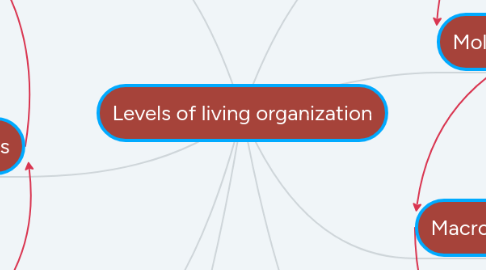Levels of living organization
by Rebecca Reiss

1. Organs
1.1. Humans have five vital organs that are essential for survival. These are the brain, heart, kidneys, liver and lungs.
1.2. The human brain is the body's control center, receiving and sending signals to other organs through the nervous system and through secreted hormones.
1.3. There are 78 organs in the human body.
2. Cells
2.1. Cells are the basic structure and function of living things.
2.2. The human body is composed of trillions of cells
2.3. Cells provide structure for the body, take in nutrients from food and carry out important functions.
3. Tissues
3.1. Human body tissue makes up organs and other body parts.
3.2. There are four main types of tissue: muscle, epithelial, connective and nervous.
3.3. Each is made of specialized cells that are grouped together according to structure and function.
4. organ system
4.1. An organ system is a group of organs that work together as a biological system to perform one or more functions.
4.2. Each organ system does a particular job in the body, and is made up of certain tissues.
4.3. The human body is made of 11 important organ systems, including the circulatory, respiratory, digestive, excretory, nervous and endocrine systems. They also include the immune, integumentary, skeletal, muscle and reproductive systems. The systems work together to maintain a functioning human body.
5. Macromolecule
5.1. A macromolecule is a very large molecule
5.2. such as protein, commonly created by the polymerization of smaller subunits.
5.3. They are typically composed of thousands of atoms or more. The most common macromolecules in biochemistry are biopolymers and large non-polymeric molecules.
6. Atoms
6.1. An atom is the smallest constituent unit of ordinary matter.
6.2. lasts forever
6.3. bonds
7. Molecule
7.1. A molecule is an electrically neutral group of two or more atoms held together by chemical bonds.
7.2. Molecules can have different shapes
7.3. Some are long spirals while others may be pyramid shaped. A perfect diamond is a single molecule made of carbon atoms.
8. organelles
8.1. An organelle is a specialized cellular structure in eukaryotic cells analogous to an organ in the body.
8.2. Organelles are discrete structures within the cell that perform a specialized function.
8.3. Most are surrounded by internal membranes and can be seen in the light or the electron microscope.


